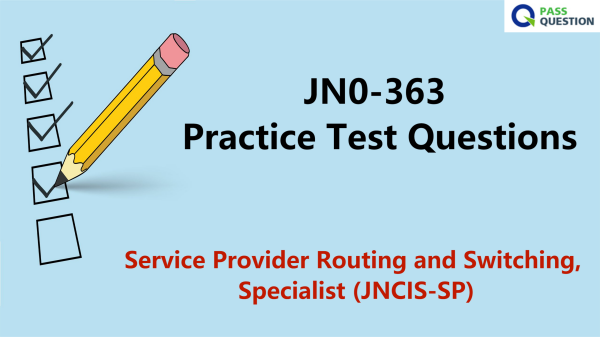JN0-363 Practice Test Questions - Service Provider Routing and Switching, Specialist (JNCIS-SP)
JN0-363 is a new exam for the Service Provider Routing and Switching, Specialist (JNCIS-SP) certification to replace the JN0-362 exam. PassQuestion newly released JN0-363 Practice Test Questions to assure your success in the Juniper JN0-363 Exam. These JN0-363 Practice Test Questions cover all the topics of the JNCIS-SP exam that you need to prepare before taking your JN0-363 exam. If you want to confirm your success in the Juniper JN0-363 exam, then learn all these JN0-363 Practice Test Questions properly. PassQuestion is quite confident that the Juniper JN0-363 Practice Test Questions will not ace your preparation but also enable you to pass this challenging Juniper JN0-363 exam with flying colors.

Service Provider Routing and Switching, Specialist (JNCIS-SP)
The Service Provider Routing and Switching track enable you to demonstrate a thorough understanding of networking technology in general and Juniper Networks service provider routing and switching platforms. JNCIS-SP, the specialist-level certification in this track, is designed for networking professionals with beginner to intermediate knowledge of routing and switching implementations in Junos. The written exam verifies your basic understanding of routing and switching technologies and related platform configuration and troubleshooting skills.
Exam Details
Exam Code: JN0-363
Exam Type: 65 multiple-choice questions
Exam Length: 90 minutes
Delivered by Pearson VUE
Prerequisite Certification: JNCIA-Junos
Software Versions: Junos OS 21.2
Exam Objectives
Protocol-Independent Routing
Open Shortest Path First (OSPF)
Intermediate System to Intermediate System (IS-IS)
Border Gateway Protocol (BGP)
Layer 2 Bridging or VLANs
Spanning-Tree Protocols
Multiprotocol Label Switching (MPLS)
IPv6
Tunnels
High Availability
View Online Service Provider Routing and Switching, Specialist (JNCIS-SP) JN0-363 Free Questions
1. You have configured multiple IP-IP tunnels across your network to provide connectivity to remote sites.
Which technique is used to help the IP endpoints in your network determine the optimal packet size to send across your tunnels?
A. path MTU discovery
B. fragmentation discovery
C. end-to-end MTU discovery
D. packet throughput discovery
Answer: A
2. To prevent fragmentation issues across a GRE tunnel, which MTU value is recommended for the tunnel to accommodate most IP packets?
A. 1476
B. 1492
C. 1500
D. 1524
Answer: D
3. Which two statements are true about the LACP protocol? (Choose two.)
A. It exchanges BPDUs to ensure all member links are functioning properly.
B. It monitors and controls the member links that form a single logical channel.
C. It acts in one of two modes: active and passive.
D. It is used to exchange control information between two MC-LAG network devices.
Answer: B, C
4. Which three protocols can be encapsulated within a GRE tunnel on a Junos device? (Choose three.)
A. AppleTalk
B. Aggregated Ethernet
C. IPv6
D. MPLS
e) Ethernet
Answer: A, C, D
5. In the evaluation of an RSTP configuration BPDU, which two values are contained in the Bridge ID value? (Choose two)
A. root bridge address
B. priority
C. originating bridge address
D. port number
Answer: B, C
6. You have been asked to configure an IPv6 address for a group of interfaces that could belong on different routers. If a packet is sent to that address, it should be received by all routers in the group.
Which address type would be suited for these requirements?
A. Unicast
B. Multicast
C. Anycast
D. Broadcast
Answer: B
7. On a Junos device with dual Routing Engines (REs), which two statements correctly describe the expected behaviour if the primary RE fails? (Choose two.)
A. The backup RE will assume the master role once the Packet Forwarding Engine (PFE) restarts.
B. The backup RE will immediately assume the master role.
C. The new master RE restarts the routing protocol process (rpD. and establishes any required adjacencies based on the configuration.
D. The new master RE maintains the existing protocol adjacencies initially established by the previous master RE.
Answer: A, C
8. In which two environments would BGP add value? (Choose two)
A. an enterprise environment with a single upstream connection
B. an enterprise environment with multiple upstream connections
C. a service provider environment
D. a home office environment
Answer: B, C
9. You must configure your dual-RE Junos device to allow failover to the backup RE without causing protocol or data plane disruption for neighboring devices.
Which two configuration statements are required to accomplish this task? (Choose two.)
A. set chassis redundancy graceful-switchover
B. set routing-options nonstop-routing
C. set routing-engine redundancy
D. set routing-options graceful-restart
Answer: A, B
10. You observe that VPN routes are hidden on your PE router. Which situation accounts for these hidden routes?
A. The protocol next-hop is not found in inet.3
B. The protocol next-hop is not found in mpls.0
C. The protocol next-hop is not found in bgp.l3vpn.0.
D. The protocol next-hop is not found in inet.2.
Answer: A
- TOP 50 Exam Questions
-
Exam
All copyrights reserved 2025 PassQuestion NETWORK CO.,LIMITED. All Rights Reserved.

